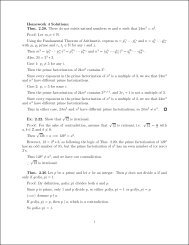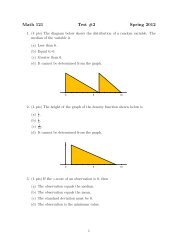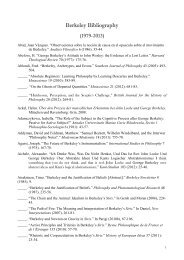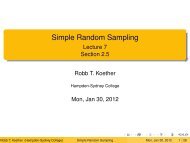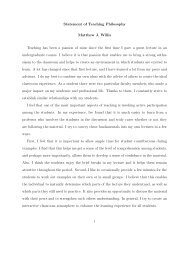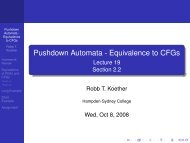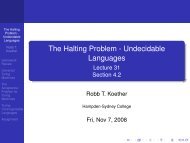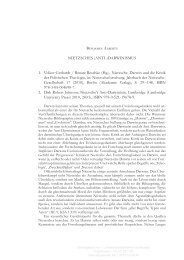Berkeley Is Pronounced Barclay - Home Pages
Berkeley Is Pronounced Barclay - Home Pages
Berkeley Is Pronounced Barclay - Home Pages
- No tags were found...
Create successful ePaper yourself
Turn your PDF publications into a flip-book with our unique Google optimized e-Paper software.
<strong>Berkeley</strong> <strong>Is</strong> <strong>Pronounced</strong> <strong>Barclay</strong>By Richard A. WatsonWashington University, (St. Louis)In response to my inquiry about how <strong>Berkeley</strong> is pronounced,four scholars responded. Patrick G. Kirby, Chairman of the Boardof Review, Department of Employment and Training, State ofRhode <strong>Is</strong>land and Providence Plantations, writes as follows:In 1985 as Mayor of Newport, Rhode <strong>Is</strong>land, 1 wasparticipating in the <strong>Berkeley</strong> Tri-centenary celebrations inCloyne, Co. Cork, Ireland, and a descendent of Bishop<strong>Berkeley</strong> told the assembled gathering that it was "Bark-ley"in his family. This comment was in response to a questionposed by one of the participants at the gathering. There wasa division among the assembled as to which version wascorrect. As a lifetime resident of Newport, Rhode <strong>Is</strong>land, Igrew up with the "Burkley" version, but after marrying aDubliner and spending a portion of the past thirty years inIreland, 1 am now a "Barkley" adherent.Professor John Troyer of the University of Connecticut writes:My thesis advisor, Roderick Firth, claimed he was the lastBerkeleian, and for him <strong>Berkeley</strong>'s name rhymed with'darkly'. All the philosophers I know agree, but the onlyevidence 1 have found which supports this consensus comesfrom Luce's biography:In the College Books of the day his name is spelt in fivedifferent ways - <strong>Berkeley</strong>, Berkley, Berkly, Berkely andBarkly - the last seeming to determine thepronounciation. <strong>Berkeley</strong> himself always, I think, spellsit with three "e'"s.
BERKELEY IS PRONOUNCED BARCLAY(A. A. Luce, The Life of George <strong>Berkeley</strong>. Bishop ofCloyne, London, Thomas Nelson and Sons. 1949, p. 24).Since there is a tradition of sorts of spelling 'bark' as 'berk'and no tradition of spelling 'berk' or 'burk' as 'bark', I thinkLuce's remark has some weight - if someone who had onlyheard <strong>Berkeley</strong>'s name wrote 'Barkly', it probably did rhymewith 'darkly.The most extensive comment is from Harriet Jeffrey, ProfessorEmeritus of the University of Colorado:One piece of evidence that 'Barklay' is right lies in the parishrecords of the Trinity Church, Newport, huge volumes whichare kept in a fire-proof basement safe-room in TrinityChurch. The sexton or assistant sexton admitted me to thevault with his keys whenever I went there. Canon Ballardhad told me to investigate for myself, and I believe it washe who first mentioned the <strong>Barclay</strong> spelling to me while wewere residents in the nineteen fifties. In the summer ofnineteen sixty three, I was given access to the room, andspent hours under a bare lightbulb, reading many notationsabout G.B. The notes record such things as the Sundays whenhe preached at Trinity, his baptising his three negroes andgiving them his name, and so on. One scribe wrote the namein perfect clarity as <strong>Barclay</strong>.Septr14 Caesar [?] Dalton21 Mary WestonHenry <strong>Barclay</strong> Son of Dean <strong>Barclay</strong>Baptised by his Fatherand recieved into the church Septr 21.RICHARD A. WATSONIf you are familiar with Newport, you will have noted thatthe street name in town is pronounced "Burkly" as is theavenue running east of the lane to Whitehall. Quite naturallywe have Americanized "<strong>Berkeley</strong>", but it is ironic that<strong>Berkeley</strong>, California was named for him as a tribute to hishopes for the advancement of learning and culture in theNew World, and that the American pronounciation obscuresthe connection!Incidentally, I know of no evidence that there was "an Irishpronunciation" of G. B. 's name. His English antecedents wereknown, and his Irish born friend, Jonathan Swift, would nothave introduced him to Pope, Addison et.al. as "Burkly".Certainly the educated Irish I have known call him'<strong>Barclay</strong>"! That includes Professor E. J. Furlong of TrinityCollege, Dublin University, who came over for the CharterMeeting of the International <strong>Berkeley</strong> Society in April 1977in Newport.Finally Alan Gabbey, former head of the Department of theHistory of Philosophy and Science at Queen's University, Belfast,says that the pronounciation is "<strong>Barclay</strong>" and that it is mostprobably the same family name as that of <strong>Barclay</strong>'s Bank. Thisseems to be pretty much to settle the issue, but if anyone has adissenting view I'd like to hear it.3Obviously he was familiar with Newport's most famous newresident, but had never seen his name in print or correctlyhandwritten. But I bless this unknown recorder who spelledthe name phonetically!Editor's Note: <strong>Berkeley</strong> Newsletternote on the same point.Vol. 3 (1979) p. 16 has a short
ReviewsGeorge <strong>Berkeley</strong> De Motu and The Analyst: A Modern Editionwith Introductions and Commentary, Edited and Translated byDouglas M. Jesseph, Dordrecht, Kluwer Academic Publishers, 1992,Pp. x + 230 £51.00A tendency in recent critical work on De Mofu has been to relateit to certain current preoccupations in philosophy of science.Examples of this are Popper's discussion of <strong>Berkeley</strong> as aninstrumentalist" and various interpretations relating <strong>Berkeley</strong>'sviews to those of Mach and logical positivism. A feature of thistendency has been to ignore the specific historical context of thetext. Gerd Buchdahl's magisterial Metaphysics and the Philosophyof Science (1969) avoided this unhistorical approach and related<strong>Berkeley</strong> more closely to his contemporaries, presenting hisscientific views as a more rigorous development of those of Locke.While Richard Brook emphasised the role of <strong>Berkeley</strong>'s doctrine ofmeaning in relation to questions in the foundations ofmathematics and physics, in his <strong>Berkeley</strong>'s Philosophy of Science(1973). he also avoided the temptation of making <strong>Berkeley</strong> aprotagonist in twentieth-century controversies.Douglas Jesseph takes the same stance and assiduouslyavoids discussing <strong>Berkeley</strong>'s work in relation to contemporarydisputes. He presents a new translation of De Motu withoriginal text. He also includes an edition of The Analyst withintroductions to both texts. bibliographies and indices. Hisrationale for this publication is,theREVIEWSto present <strong>Berkeley</strong>'s two most important scientific texts in aform which meets contemporary standards of scholarshipwhile rendering them accessible to the modern reader.(p. ix)Unfortunately the goal is not entirely achieved, since in dealingwith De Motuthe book falls short of the standards of scholarshipcited, as I shall discuss. To a lesser extent this is also the case withThe Analyst.De Motuis introduced by ieviewing the major controversiesabout motion which influenced <strong>Berkeley</strong>. First there is an accountof the views of motion of a) Aristotle and the scholastics, b)Descartes and Galileo, c) Leibniz and d) Newton. The brief accountof Aristotelian and Medieval theories about motion relies on datedstudies and has no references to primary sources. This may beexcused, perhaps, since Jesseph states that "<strong>Berkeley</strong> apparentlyhad no detailed knowledge of Aristotelian and scholastic theoriesof motion" (p. 9). The sections on Galileo, Descartes and Leibniz arebetter served in this respect, with apposite quotations to illustratethe issues discussed. However the discussions are rather short.and indeed the section dealing with Newtonian mechanics hasdisproportionately long quoted passages to the small amount oftext.After this Jesseph presents particular disputed issues, suchas the "Vis Viva Controversy", Percussion and Gravitation. Thisserves as a brief orientation to reading De Motu, but there is noattempt at presenting interesting interpretative angles on the text.The four pages devoted to "The Place of De Motuin <strong>Berkeley</strong>'s5
6REVIEWSPhilosophy" do not adequately deal with this issue. While merelystating that metaphysics and physics are separate provinces for<strong>Berkeley</strong>, Jesseph doesn't explore the rationale for andimplications of this position. A brief paragraph mentions that Luceheld that immaterialism was central to understanding De Motu,without any attempt to assess this claim. The same paragraphmentions the positivist reading of <strong>Berkeley</strong>, again without anyengagement. Nor does the couple of hundred words under theheading "A Note on the Text and Translation" constitute acontribution to <strong>Berkeley</strong> scholarship.As to the translation, the stated aim was to balanceconsiderations of readability against those of accuracy - whichresulted in "a fairly literal translation which can still be read withrelative ease" (p. 37). The main translation hitherto available wasthat of Luce in Works, also reprinted in the Everyman edition ofPhilosophical Works, M. R. Ayers (ed.). One way in which thepresent translation is an advance on the Luce version is theinclusion of footnoted references to quotations and allusions toother philosophers. However, the translation itself doesn't alwayshave the limpidity and clarity of the Luce version and the latinatesyntax sometimes occludes the sense. For example;REVIEWSIn the pursuit of truth we must beware of being misled byterms which we do not rightly understand. That is the chiefpoint. Almost all philosophers utter the caution; few observeit. (Luce).Quo modo curva considerari potest tanquam constans exrectis infinitis, etiamsi revera ex illis non constet, sed quodea hypothesis ad gometriam (sic) ufilis sit, eodem motuscircularis spectari potest. tanquam a directionibus rectilineisinfinitis ducens, quae suppositio utilis est in philosophiamechanics. (*61)Just as a curve can be considered as consisting of an infinityof right lines, even if in truth it does not consist of them butbecause this hypothesis is useful in geometry, in the sameway circular motion can be regarded as traced and arisingfrom an infinity of rectilinear directions, which suppositionis useful in mechanical philosophy. (Jesseph)A curve can be considered as consisting of an infinitenumber of straight lines, though in fact it does not consist ofthem. That hypothesis is useful in geometry; and just socircular motions can be regarded as arising from an infinitenumber of rectilinear directions- which supposition is usefulin mechanics. (Luce).However, the single most glaring feature of Jesseph'sbook,illustrated in the Latin text of section 61, quoted above, is theproliferation of the most appalling typographical errors.Misspellings abound, print is smudged, abominations (in this ageof word-processing) such as "And surely when we when we call abody heavy ..."(p. 83) mar the text.7Ad veritatem inveniendam praecipuum est cavisse ne vocesmale intellectae nobis officiant: quod omnes fere monentphilosophi, pauci observant. (*I)In the pursuit of truth the most important thing is tobeware that poorly understood words do not hinder us:nearly all philosophers warn of this, but few heed thewarning. (Jesseph)The bibliography for De Motu is comprehensive, but not complete- missing for example the 1989 Italian translation by MariapaolaFimiani which had lengthy historical studies and which addressedthe relationship between that work and immaterialism.
8REVIEWSJesseph is on different ground in dealing with The Analyst.He is prepared to make stronger philosophical claims for it. It ispresented as an essential pan of our understanding of <strong>Berkeley</strong>'saccount of science and mathematics and Jesseph claims that it isindependent of immaterialism (however still no discussion ofthis). He forays into the heady world of <strong>Berkeley</strong> scholarship indiscussing the possible identity of the 'infidel mathematician'attacked in the text. His presentation of the mathematicalbackground is detailed in comparison to his discussion of themechanical background to De Motu and his discussion of theelements of the infinitesimal calculus and Newton's calculus offluxions is clear, as is his account of <strong>Berkeley</strong>'s arguments againstthese. The 'outline analysis' of The Analyst is useful for thoseunfamiliar with that work. Once again the discussion of responsesto <strong>Berkeley</strong>'s position is scanty, as is the note on the text.As an introduction to the two texts it serves well - but no<strong>Berkeley</strong> novice would buy so expensive a work (£51.00)Specialists in <strong>Berkeley</strong> gain no great insights from theintroductory material and no detailed interpretative strategy ispresented. <strong>Is</strong>sues which could be addressed are sidestepped, suchas the immaterialism issue, the relation of theory of meaning toontology, etc.. It (rightly) claims no superior status for itstranslation of De Motu or the text of The Analyst over preexistingversions. What is puzzling about this book is who mightconstitute its intended readership.Paul O'CradyTrinity College Dublin9REVIEWSVision: Variations on Some Berkeleian Themes. Robert Schwartz,Oxford, Basil BIackwell, 1994, Pp. 162.This relatively short book, in four chapters, addresses some keyissues in the theory of vision: the manner in which we perceivedistance and size. and the nature and relevance of inference in theperceptual process. These issues are presented in the context of<strong>Berkeley</strong>'s seminal work on vision and throughout the book theauthor is at pains to present an impartial account of <strong>Berkeley</strong>'swork in the light of subsequent research. Appropriately, the bookconcludes with a comparison of <strong>Berkeley</strong>'s position with that of J.1. Gibson.Perhaps one of the most engaging qualities of the book is thefairness with which Schwartz treats not only <strong>Berkeley</strong> but all ofthe other "vision theorists", psychologists, and philosophers whopopulate the pages. Indeed, it is the willingness to attempt to see"what was really meant" in <strong>Berkeley</strong>'s writings, rather than beingcontent with the (often incorrect) interpretations of others, whichcontinually provides one with the motivation to carry on readingeven when one disagrees with Schwartz's perspective. Given that<strong>Berkeley</strong>'s writings are very often misunderstood, this is a verywelcome characteristic. Indeed, as a companion to <strong>Berkeley</strong>'s owntext, this book would play a very useful role in keeping a reader'sprejudices at bay whilst coming to an understanding of <strong>Berkeley</strong>'sintended message. Nonetheless Schwartz is no apologist for<strong>Berkeley</strong>; rather he provides an impartial assessment of<strong>Berkeley</strong>'s position on vision, an altogether more comfortableendeavour.
inREVIEWSREVIEWS11From a Berkeleian perspective, Chapter 1 of Schwartz's bookis undoubtedly the most interesting and compelling. It takes<strong>Berkeley</strong>'s position on distance and views it from the differentperspectives of subsequent vision theorists. If I can pick out onesingle detail for mention, it is the problem of calibrating one'sperceived distance (or "egocentric distance") with absolutedistance (or "ecocentric distance"). For <strong>Berkeley</strong>, this isaccomplished by learning, through association of the perceiveddistance and the actions of the perceiver in his environment. Thatis, it is achieved through the association of proprioceptiveinformation with exteroceptive information. This is an issue ofgreat contemporary interest in psychology, epistemology, andcomputational perception, and Schwartz does no small service inreminding us that it is not a new problem. He also provides avery well presented discussion on the nature of binocularstereopsis and, in particular, on the relevance of stereopsis to<strong>Berkeley</strong>'s position. Contrary to common belief, stereopsis doesnot damage in the least <strong>Berkeley</strong>'s case for the indirectness of theperception of distance and it is instructive to read Schwartz'saccount of this.Chapter 2 treats the perception of size and, inter alia, how itis we perceive given objects to have a constant size irrespective oftheir distance from us and in spite of the consequent variation inthe size of the image which is projected onto the retina.<strong>Berkeley</strong>'s position on this issue is that the perception of size isachieved through the association of the tangible size of objectswith (a) the visible size of an object - the tangible size beingproportional to the visible size: (b) the relative blur of the visualappearance - tangible size being inversely related to the degree ofblur; and (c) the intensity of the visual appearance - the tangiblesize being inversely related to the intensity. Unfortunately, mostof the chapter is given over to a discussion of a position that<strong>Berkeley</strong> himself rejects: the so-called 'taking account of distance'thesis. This thesis posits that the magnitude of an object isperceived by the prior estimation of its distance from theobserver and by exploiting this information with a knowledge ofthe visual angle subtended by that object at the retina of the eye.Chapter 3 on perceptual inference introduces manyinteresting issues, not the least of which is Schwartz's observationthat <strong>Berkeley</strong>'s theory of vision can be construed as a thesis thatthe perceptual process is like linguistic undertanding. That said,very little of chapter 3 addresses overtly Berkeleian issues. Thisis not surprising given that Berekeley argued strongly that visualperception does not involve any sort of deliberate inferential (orreasoning) process. This is no criticism of the book for, as Schwartzpoints out, a great deal of modern vision theory presumes thevalidity of the inferential position. Again, the service whichSchwartz does is to assess this purported validity in a balancedmanner. In doing this, Schwartz notes a distinction (as he doeselsewhere in the book) between organic or physiological processesof visual sensing, on the one hand, and psychic or psychologicalprocesses, on the other. Schwartz's point is that it is very difficultto say with any confidence where one should draw this distinctionin the first place. Arguments for the validity of perceptualinference are often based, for example, on some inadequacy ininformational content which results from purely physiological
12REVIEWSREVIEWSprocesses and the consequent necessity to invoke somecompensatory psychological processes. Schwartz's solution is toside-step the issue completely. He argues that it is the drawing ofthe distinction in the first place which causes the difficulty bygiving vision theorists irrelevant (and non-existent) problems tosolve - 'bogus controversies' as he calls them. His arguments areappealing. I have, however, to say that I believe he draws anunsupported conclusion when he asserts: 'much of the air shouldbe knocked out of the debates over whether ... a realist or antirealistaccount of vision is correct'. This assertion seemsunsupported because Schwartz has almost systematically avoidedbecoming engaged in any deep consideration of the ontologicalfoundations of vision, a matter I will return to in a moment.Chapter 4, and the book, concludes with an all-too-brief lookat the ontological foundations of vision theories. Given <strong>Berkeley</strong>'sown priorities, arguably the book finishes perhaps as it shouldhave begun. Schwartz makes some very valuable and evenhandedobservations on these ontological issues. For example, hestates that 'the realist thesis of a world ready-made, independentof our contribution, is no more tenable than the idea that theworld is whatever we fancy it to be'. And he notes, in passing, that'a radical subjectivist thesis is no part of <strong>Berkeley</strong>'s idealism.'Indeed as so often in the book, this is a pertinent and thoughtfulobservation which can go some way to correcting commonmisconceptions.Chapter 4 is primarily concerned with the work of Gibson, avision theorist almost as controversial as <strong>Berkeley</strong>. In thisinstance, <strong>Berkeley</strong> acts as a backdrop for Gibson and the purposeof the chapter seems to be to present an impartial and fairassessment of the merit of Gibson's position. That said, Schwartzdoes draw some very interesting parallels between the work ofthe two men, perhaps the most important being the observationthat '<strong>Berkeley</strong> and Gibson each make much of the fact that it isour experience of the visual world that is significant forbehaviour. This leads them both to emphasize the inseparabilityof seeing and doing'. This is a very instructive, for it is somethingthat so-called modern practitioners of computational vision, forexample, are now re-discovering.Although this is a valuable and enjoyable book, it is notwithout shortcomings. Perhaps the most obvious deficiency is thatit does not contain a complete and succinct summary of <strong>Berkeley</strong>'sposition as presented in the Essay Towards a New Theory ofVision. The book also misses the opportunity to rehearse theessence of <strong>Berkeley</strong>'s arguments, for these have an elegance andbeauty all of their own, irrespective of their subject matter. Toget the most out of this book, it would be essential to have firstmade a careful reading of <strong>Berkeley</strong>'s orginal text.There is another lesser shortcoming. Although Schwartzacknowledges the importance of David Marr as a contemporarytheoretician of vision, he does not address his work in anysubstantive manner. This is a pity since Marr's work has been soinfluential on modem thought on vision and it would have been
14REVIEWSinstructive to have <strong>Berkeley</strong>'s approach contrasted with Marr'sposition, if only to highlight the strength of the Berkeleiantradition.As we noted above, Schwartz does not develop in any depththe ontolological and epistemological foundations of vision.Furthermore. Schwartz's final sentence of the book leaves onefeeling disappointed. He states that 'it would seem that seriouswork in the theory of vision can best proceed by letting thesegrander metaphysical ideas float free on their own'. This is indeedregrettable if one remembers the epistemological problem withwhich we are inevitably faced when we attempt to provide anyexposition of the nature of perception, visual and otherwise. Forany attempt at such an exposition must depend on the very thingwe are investigating, namely vision! It is clear that irrespective ofhow hard it is to deal with these issues, the ontological and theepistemological concerns inevitably raise their heads and demandto be addressed. Schwartz's desire to make progress withoutaddressing them is understandable, and he is certainly not alonein this. So one must beware of singling him out for criticism.However it is unfortunate, given that perhaps <strong>Berkeley</strong>'s mostvaluable legacy was an understanding of the deepinterdependence between our perceptual processes and ourconceptions of reality.RecentPublications on <strong>Berkeley</strong>Bclfrage. Bertil. "A Response to M. A. Stewart's '<strong>Berkeley</strong>'s IntroductionDraft'", <strong>Berkeley</strong> Newsletter. 12. 1-10. 1991-92.Berman, David, (ed.). George <strong>Berkeley</strong>: Alciphron in Focus, London.Routledge. 1993.Bennan. David. "Cognitive Theology and Emotive Mysteries in <strong>Berkeley</strong>'sAlciphron" in Bennan, George <strong>Berkeley</strong>: Alciphron in Focus, 200-213.Flew. Anthony. "Was <strong>Berkeley</strong> a Precursor of Wittgenstein?" in Bennan,George <strong>Berkeley</strong>: Alciphron in Focus. 214-226.Hughes. M. "Hermes and <strong>Berkeley</strong>", British Journal for the Philosophy ofScience, 43(1), 1-19. March 1992.- Imlay Robert A. "<strong>Berkeley</strong> and Scepticism: A Fatal Dalliance", Hume Studies,18(2). 501-510, Nov. 92.-Jacob, Alexander "The Neoplatonic Conception of Nature in More, Cudworthand <strong>Berkeley</strong>" in The Uses of Antiquity. Gaukroger. Stephen (ed.)Dordrecht, Kluwer. 1991.Jesseph. Douglas M.. George <strong>Berkeley</strong> Dc Motu and The Analyst: A ModernEdition with Introductions and Commentary, Dordrecht, Kluwer AcademicPublishers, 1992.lesseph. Douglas M.. <strong>Berkeley</strong>'s Philosophy of Mathematics. Chicago.University of Chicago Press. 1993.- Kabiloglou. E. Douka. "On the Discrimination of Platonisms in EighteenthCentury England*. Philosophical Inquiry, 15(1-2) 20-45 Sep. 93.Kline, A. David, "<strong>Berkeley</strong>'s Divine Language Argument" in Berman.George <strong>Berkeley</strong>: Alciphron in Focus, 185-199.Levine, Michael and Levi. Neil. "Robinson on <strong>Berkeley</strong>:'Bad Faith' or NaiveIdealism?", Idealistic Studies, 22(2). 163-178, May 92.Levine, Michael. "How to Make a Mistake". Philosophia (<strong>Is</strong>rael), 22(1-2). 29-37, Jan. 93.- Levy, David, M. "Bishop <strong>Berkeley</strong> Exorcises the Infinite: FuzzyConsequences of Strict Finitism". Hume Studies .18(2) 5 11-536. Nov.92.- Levy, David M. "'Magic Buffalo' and <strong>Berkeley</strong>'s 'Theory of Vision': Learningin Society". Hume Studies. 19(1) 223-226 Ap.93.David VernonTrinity College DublinLievers. Menno. "The Molyneux Problem", Journal of the History ofPhilosophy. 30(3). 399-416. Jan 92.- Lucash, Frank. S. "The Nature of Mind". Ciornale di Metafisici, 13(1) 89-107.Jan-Apr. 91.Lyons, William. "Dysart Castle: George <strong>Berkeley</strong>'s Childhood <strong>Home</strong>".<strong>Berkeley</strong> Newsletter , 12. 11-15. 1991-92.
BIBLIOGRAPHY16Morgan. Vance. "Kani and Dogrnalic Idealism: A Defence of Kant'sRefutation of <strong>Berkeley</strong>". Southern Journal of Philosoplz~, 31(2). 217-237.Sum. 93.Muehlniann. Robert G., <strong>Berkeley</strong>'.~ Ontolo#v. Indianapolis. Hacketl. 1992.Orlando, Eleonora, "Sobre el idealism0 de <strong>Berkeley</strong>". Revista de Fiiosofia,(Argentina). 7(1-2). 53-68. Nov. 92.Nezinska. E. "To Make Truth Glide intoFilozofia , 47(5), 310-312. 1992.the Soul" (in Czechoslovakian).Rotem, Oman. "An Encounter Between Philosophy and Religion". AsianPhilosophy, 3(1). 15-28. Mar 93.Saidel. Eric "Making Sense of <strong>Berkeley</strong>'s Challenge". History of PhilosophyQuarterly. 10(4). 325-339, Oct 93.Silver, Bruce S.. "Boswell on Johnson's Refutation of <strong>Berkeley</strong>: Revisitingthe Stone", Journal of the Histon of Ideas, 54(3). 437-448, July 93.Tipton, Ian. "Descartes' Demon and <strong>Berkeley</strong>'s World", Ph~losophicalInvestigation.~, 15(2). 11 1-130. Apr. 1992.Unnson. J.O. "<strong>Berkeley</strong> on Beauty". in Berman. George <strong>Berkeley</strong>:in Focus. 179-184.AlciphronWahl, Russell and Westphal. Jonathon. "Descartes, Leibnif. and Berkelcy onWhether we can Dream Marks on the Waking State", Studia Leibnitiana.24(2). 177-181. 1992.Watson, Richard A. "Malcbranche, Models and Causation", in Causation inEarly Modern Philosophy, Steven NadIer (ed.). Pennsylvania UniversityPress. 1993.



